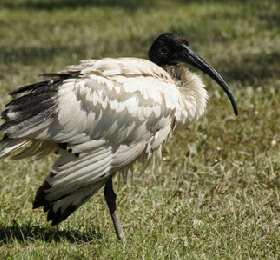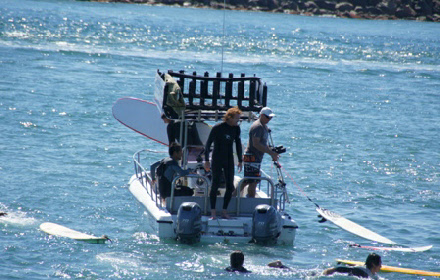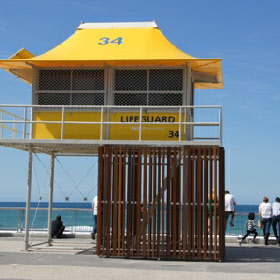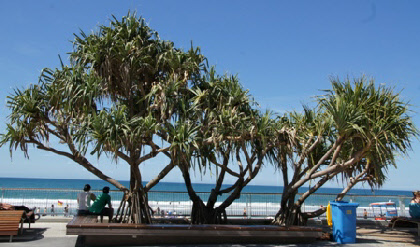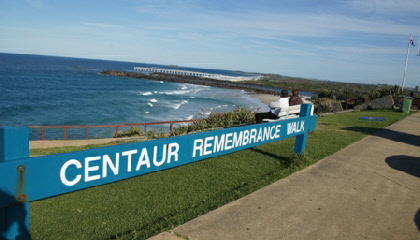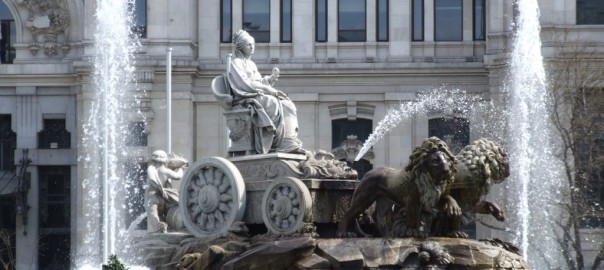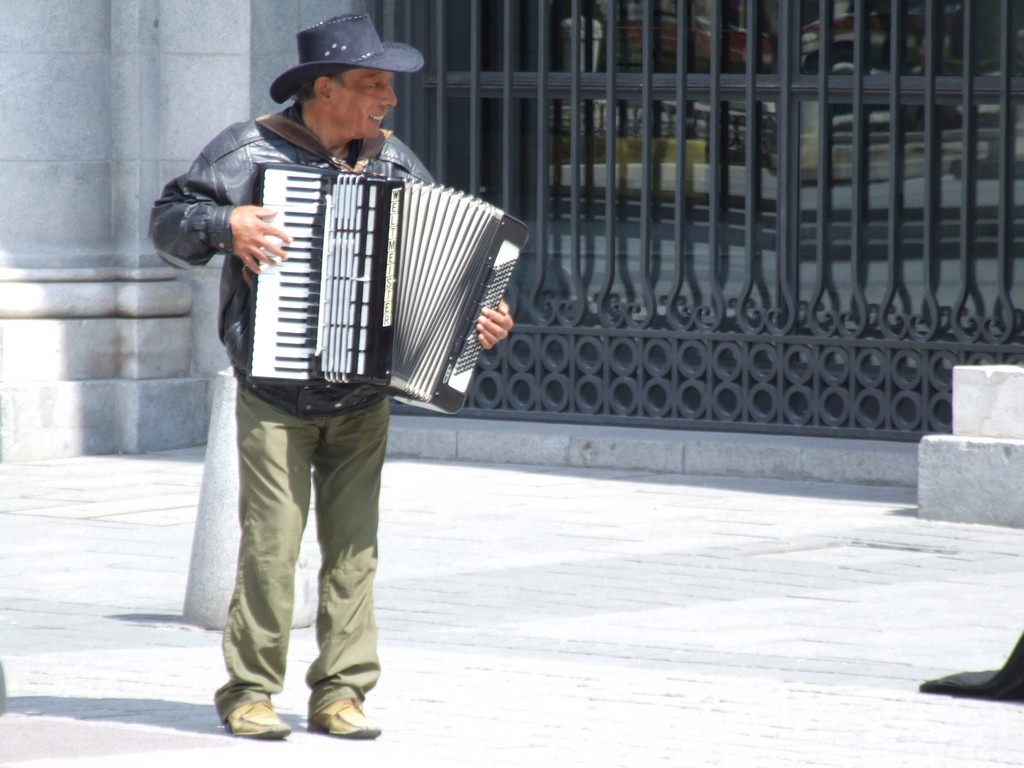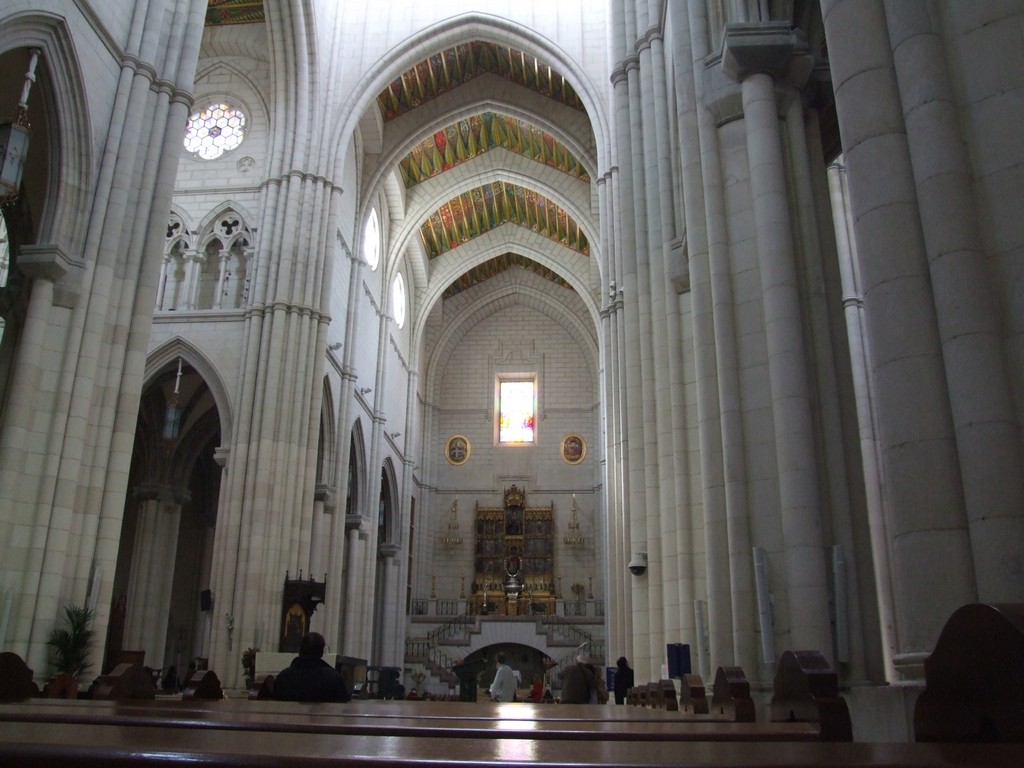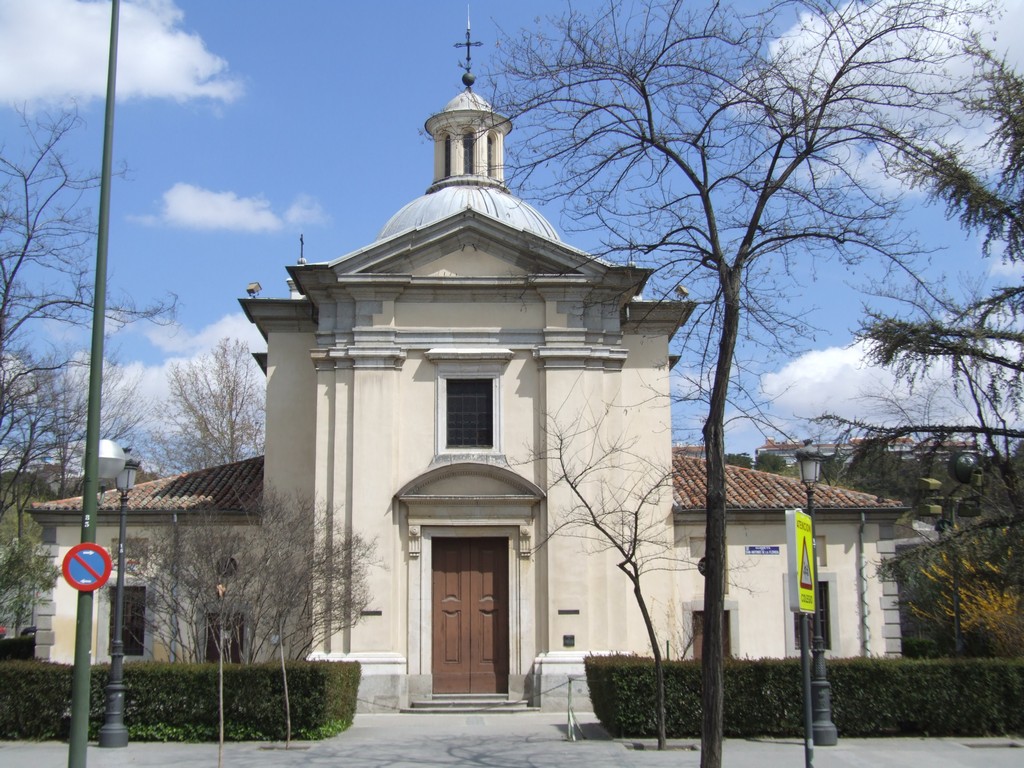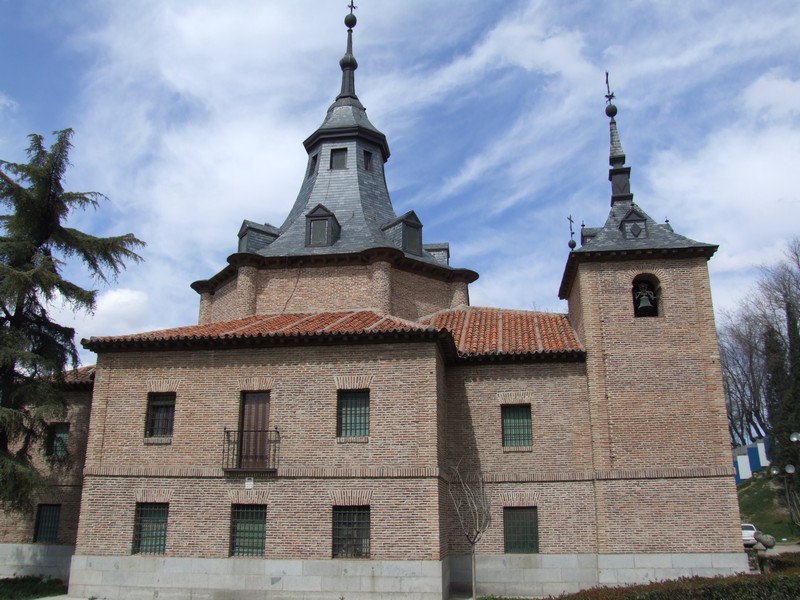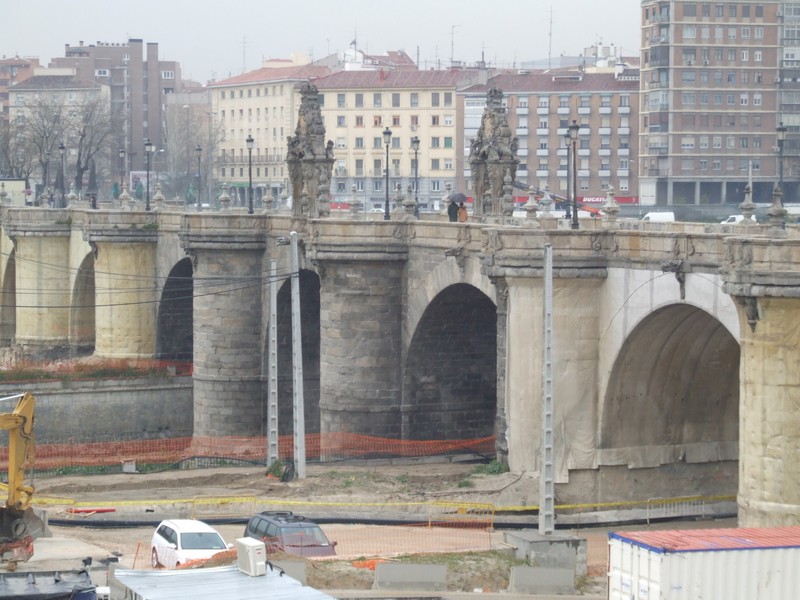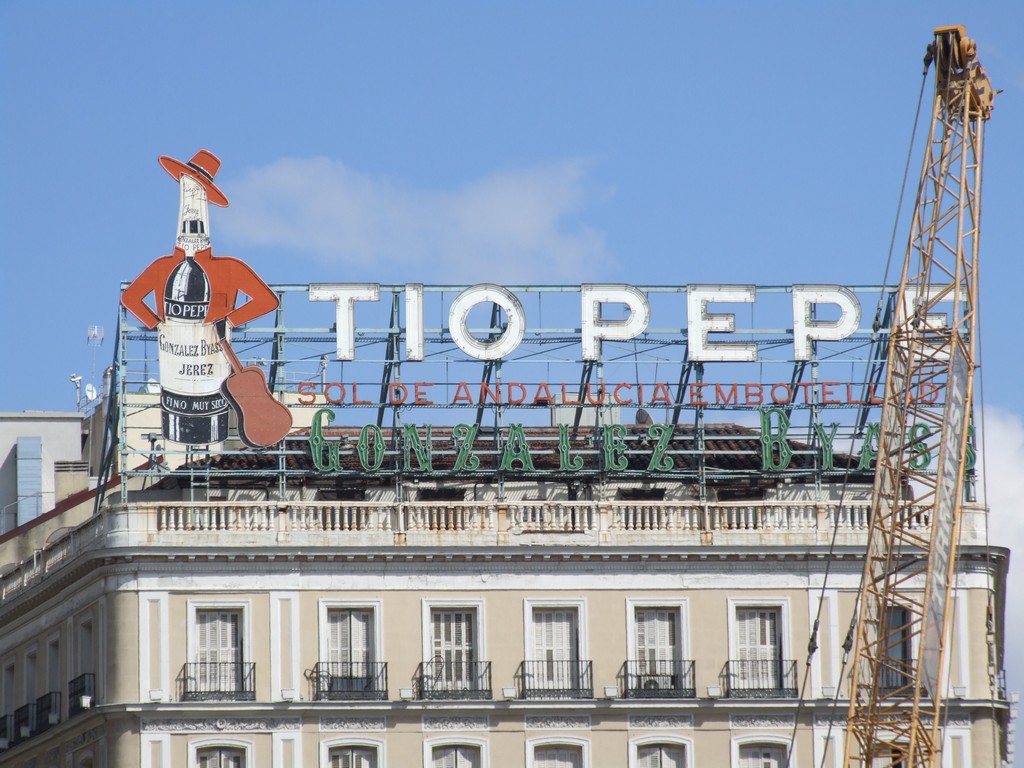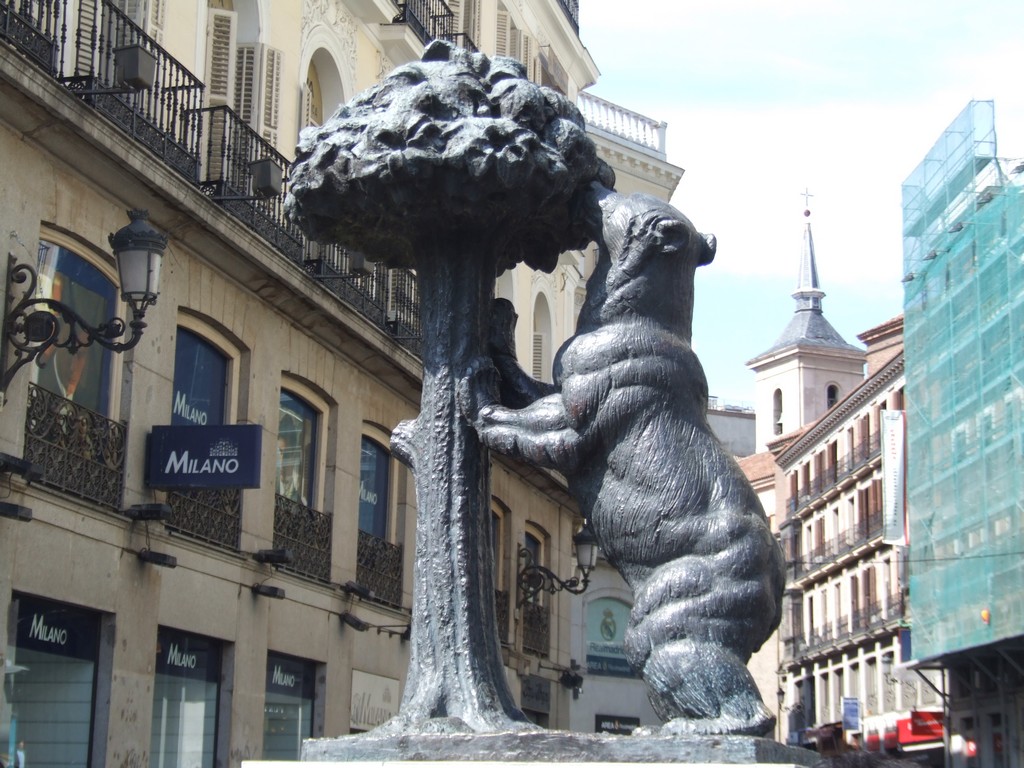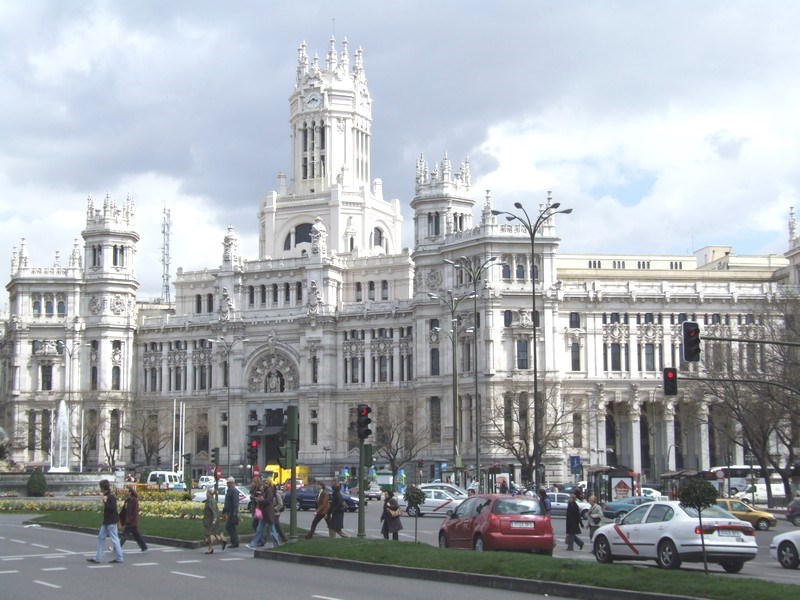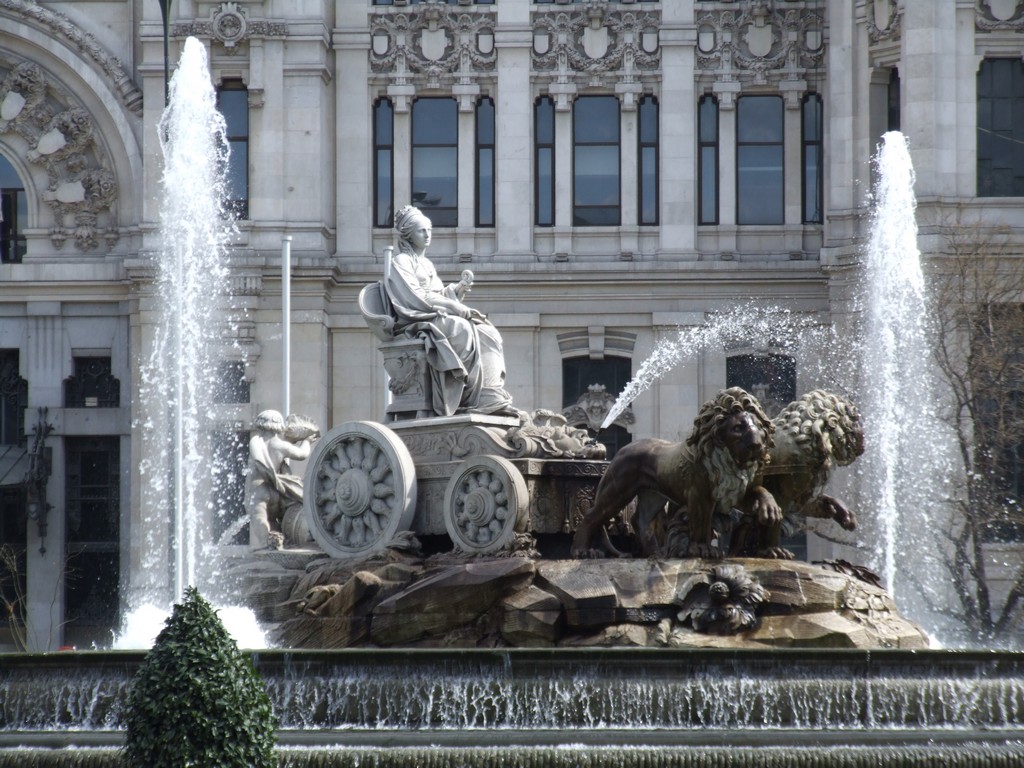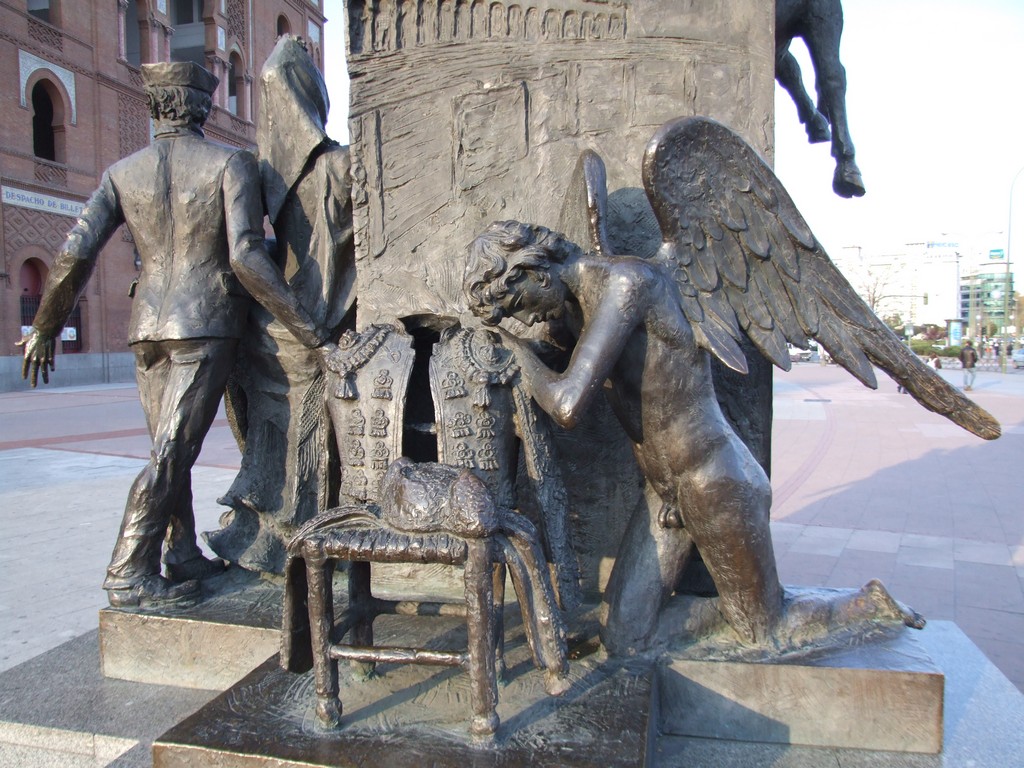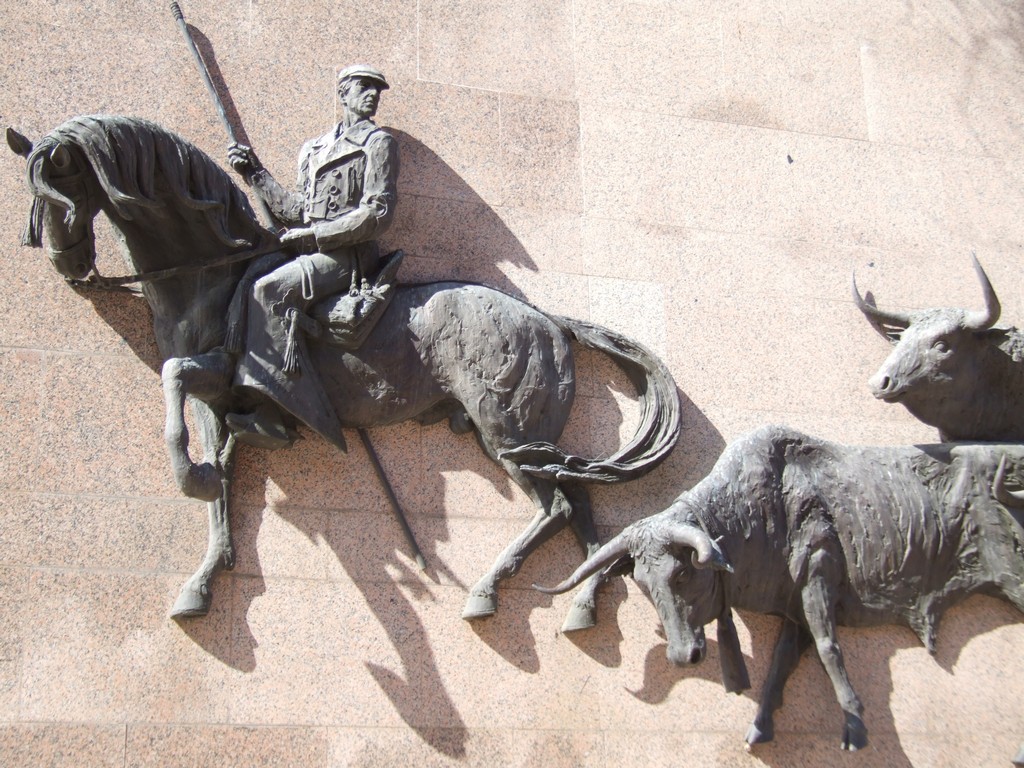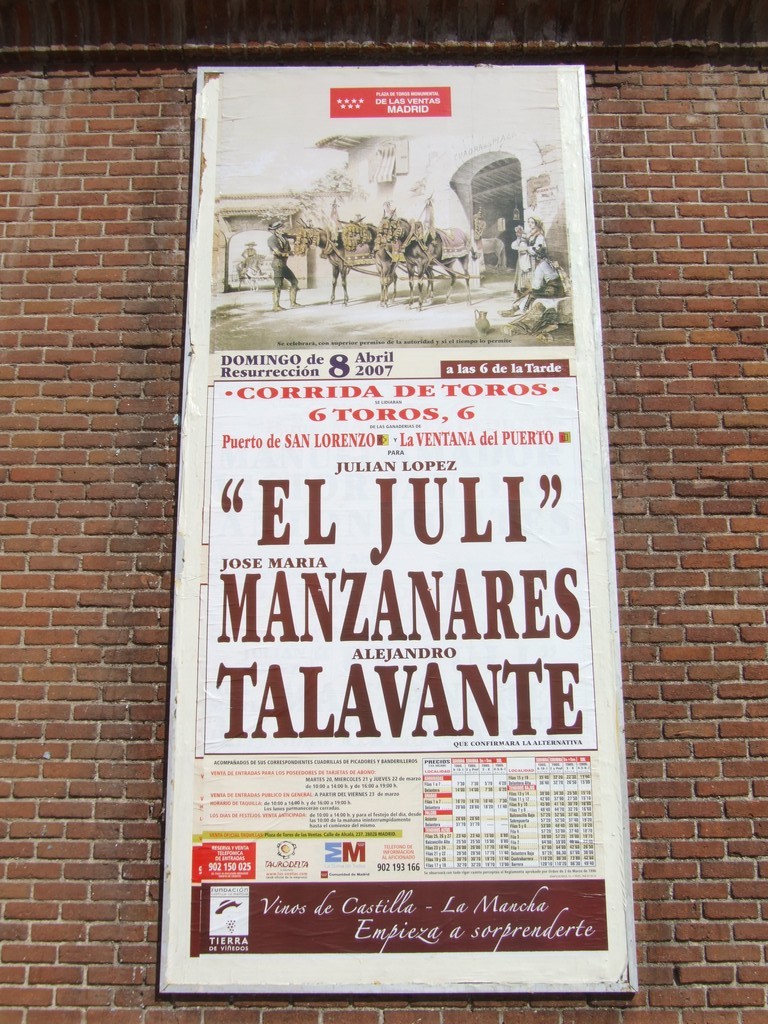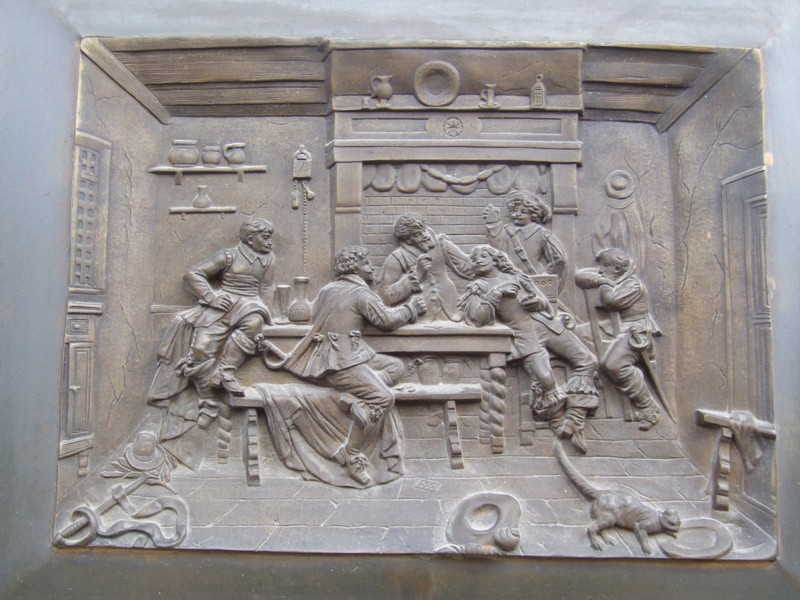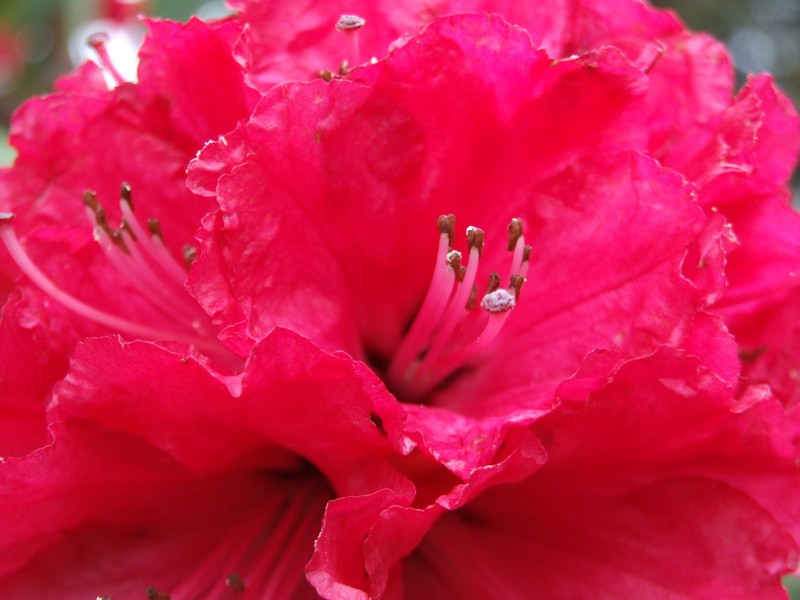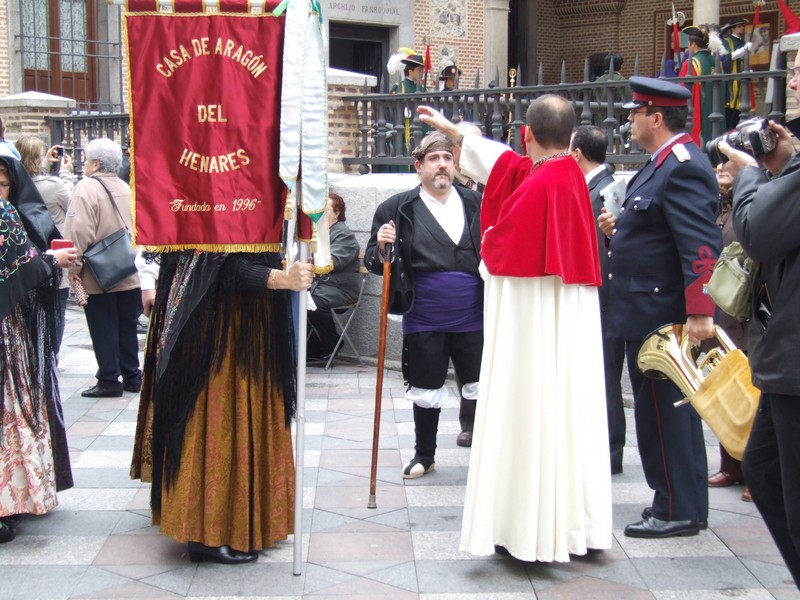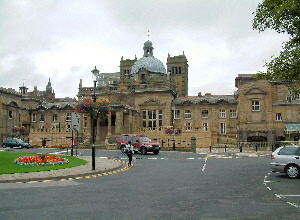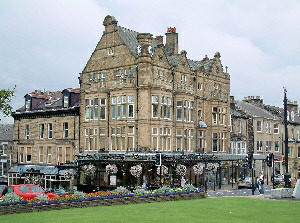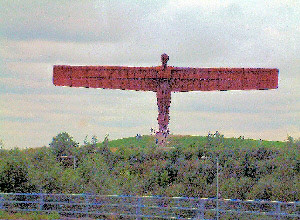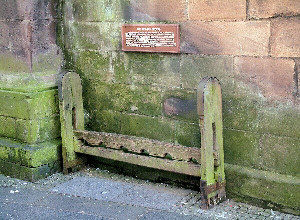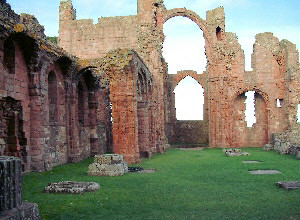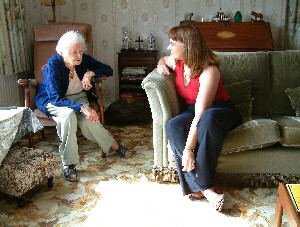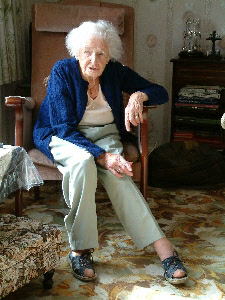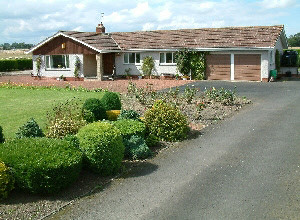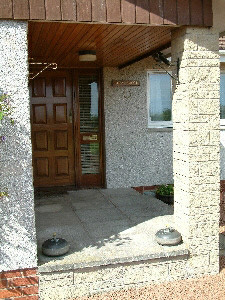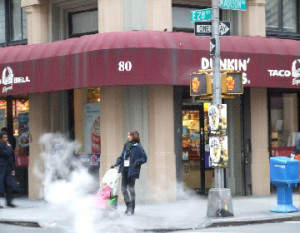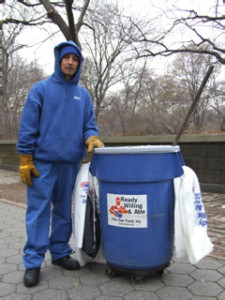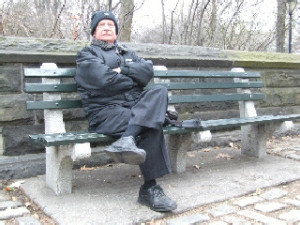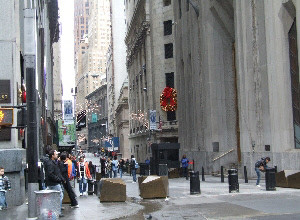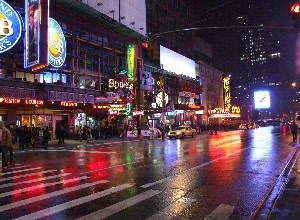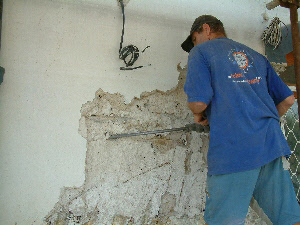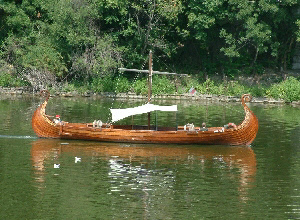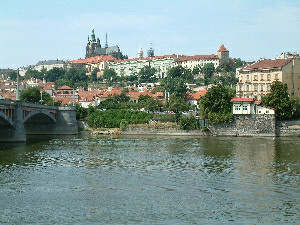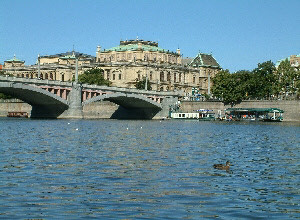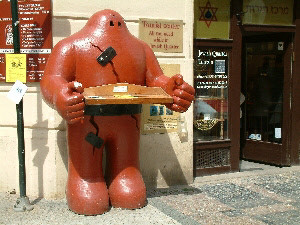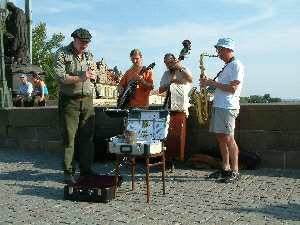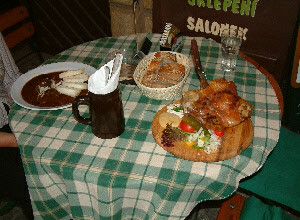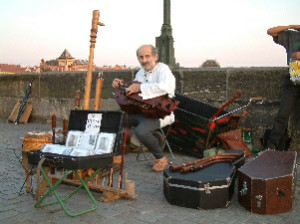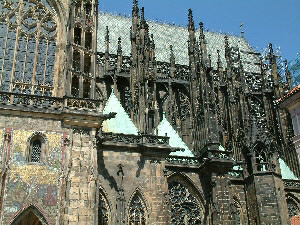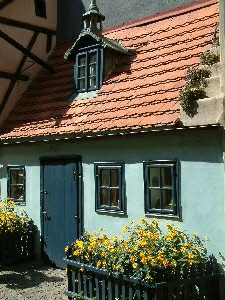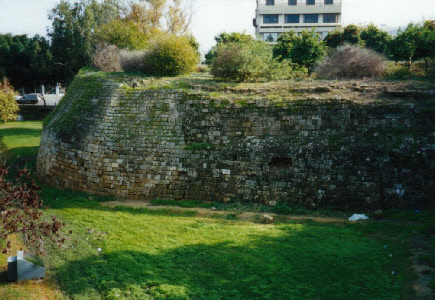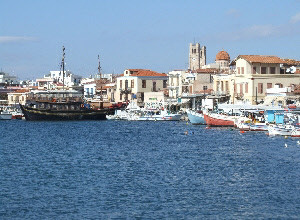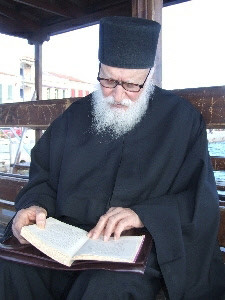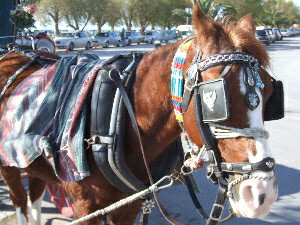We seem to have got the best weather. In the 10 days before we arrived, Cyprus was battered by huge storms, one of them with golf ball sized hailstones (said the locals) and all of them with sheets of rain and wild winds. We walked down the road from our hotel and in a dip of the road we could see that there had been a flood across the road at least 2 feet deep, because at that point, the road verge was 2 feet high and there were heavy mud stains across the footpath.
We followed the road to the sea and the beach was a mess of plastic blue and white sun lounger sofas scattered all along the sand and even up the steep bush-clad slope behind it. The ice cream vendor’s stall was smashed as was the Sea Sports Club building. The whole of Coral Bay beach was littered deep with rotting seaweed, sun loungers and broken bits of vendor shacks.
A week after we got back home Elaine spoke to one of her pupils who had started her holiday in Cyprus the day we left. Her holiday was ruined by sand storms so bad she wasn’t allowed out of the hotel and the organisers had to postpone the New Years night fireworks. But us? We had a week of glorious sunshine and 19C temperatures.
When we took off from Luton bound for Paphos, it seemed odd that we were flying in a northerly direction, but a straight line from Luton to Cyprus goes over Belgium and then the Balkans. Cyprus is so far buried at the eastern end of the Mediterranean, it’s only a half-hour flight from there to Israel and only an hour’s flight to Egypt.
We were shepherded from the plane across the tarmac to a large corrugated iron shed where we picked up our bags in the early evening gloom, passed through customs and found the bus that was transferring us to our hotel. We gave our luggage to the bus driver and rushed over to see the Med. It looked like Lake Taupo, except that it’s bigger so you can’t see the opposite shore, but the waves were similar with little white caps out to sea and a light splashing sound at our feet. There was a sharp breeze blowing in and the beach was shallow and covered in little white crystalline pebbles. There was no tide mark.
On holiday with the English
Let me tell you about the English, then I’ll tell you about Cyprus. The last person onto the bus was dressed in a green shirt and trousers and introduced himself to all of us as the Airtours transfer rep. So that’s the first thing you learn about travel from England to an overseas destination: you are a member of a tour party and everyone on the bus is a member of your tour party and you are always treated as a group, even though the members have never met. It was at about that point I realised that we were on an Airtours tour.
The tour companies lay on everything: the transfer bus to get you to and from the airport, a rep to look after your requests and complaints, the block booking at the hotel, activities and excursions during the day and entertainment at night. They had physed classes, pool activities and fun things for kids and adults to do all day, but they also offered an optional trip by coach (a big, luxury bus) to Nicosia, a day out in Egypt and an adventure tour up into the mountains.
The entertainment at night was the funniest bit. First the hotel did a buffet dinner for 5 pounds each then in a room downstairs the rep organised a 15-question quiz, then a single round of bingo with a 100 pound prize, then the real entertainment like dancing, a floor show or a karaoke night. When they do singalongs, the English have songs they absolutely adore and to those tunes they do movements such as waving their arms from side to side over their heads, or twirling their fingers or do a few line-dancing steps – all sorts of things. You’ve seen Hi-De-Hi; you’ve got the picture. They re-create Butlins everywhere. They also like their English food; soup, chips, baked spuds, lamb chops, rib roasts, sausages, boiled veges, jelly and ice cream. They don’t want foreign food, they want what they like.
I’m not trying to take the mickey; I’m trying to show you how things work. Every nation does it; all the Kiwis on their big OE live with the Aussies and South Africans in the middle of London and go to rugby matches and watch the Super 12 on Sky and drink Fosters in a local pub. You see what I mean – people like to take bits of their home with them.
When the English go to their holiday destinations, they’re not really travelling; they are going to a resort where they will get looked after and have lots of fun in a climate more agreeable than the one they left behind. In the main they don’t leave the hotel, they haven’t come to experience the local culture nor to explore the local history, they are there to be entertained and to have fun with the same expectations they would have if they were in Blackpool, Brighton or Bognor Regis.
In Cyprus
The rep explained things about Cyprus in general and our hotel in particular as the bus drove from the airport to Pahpos and then from Paphos to Coral Bay, dropping off passengers as it went. Cyprus is safe – there’s hardly any crime. It’s divided into two with the southern half being run by Greek Cypriots and the northern half by the Turks. The Greeks will tell you the Turks invaded in 1974 and the Turks will tell you the Greeks got control by staging a coup, backed by the military junta then in power in Greece.
A British army officer drew a line on the Cyprus map with a green pen to divide the island and the line is referred to as the Green Line. It goes through the middle of the capital, Nicosia, and they say that Nicosia is the last divided city in Europe. Don’t put your toilet paper down the loo, put it in the rubbish basket next to the loo. If you put it down the loo, you will block it because the pipes are too small. Your loo will backfill and it will flood your apartment. You will then need to get the hotel to send a plumber to fix it and that is VERY embarrassing.
“Eat the local food whenever you get the opportunity,” he said, “because it’s cheap and delicious. The temperatures at this time of the year are mild rather than warm, but in the summer when you step off the plane it’s like walking into a sauna. And, it hardly ever rains here, the water comes from melted snow off the mountains in the middle of the island. Don’t drink the tap water, it will give you a tummy ache, buy and drink bottled water.”
We listened carefully to all of this, because he was actually living on the island with his girlfriend so he knew a bit about it. While we listened to him we thumbed through our Thomas Cook Travellers CYPRUS book that we had bought before we left St Albans and recognised one of the place names that the coach passed – The Tombs of the Kings. So the first day was taken up entirely in travelling there. The hotel was a modern affair of Mediterranean styled villa apartments calling itself Aqua Sol Village with a very good view over the sea.
On the morning of the second day we had to wait until 11am to get our Rep’s Briefing. This was a meeting in the downstairs lounge where the rep gave us some briefing papers on Cyprus and what to expect as well as giving us invitations to various excursions and then explaining how to hire a car.
We signed up for the coach tour to Nicosia the next day, the day in Egypt, an appointment with the Avis rep the morning after the Nicosia trip to pick up our hire car and spent the afternoon exploring Coral Bay on foot. In the middle of the village is a nightclub, a couple of jewellers, several restaurants, some real estate agents, a small supermarket and a few souvenir shops.
The eyecatcher, though, was the Blazing Saddles pub with proper steak meals, real English food and Sky television with a rolling display of all the English soccer games and when they would be shown – live, of course – on their big screen. All the businesses were open but there were very few customers.
Coral Bay itself is M-shaped, except that the middle leg is quite short, and sweeps upward from the sea inland to an horizon at least 400ft above sea level. On every yard of that uphill sweep, developers are building houses. Their owners will have a fantastic view of the lapis-blue Med, but there will be a terrible cost to the crumbly, rocky, barren hillside while the individual buildings are just one Mediterranean design endlessly repeated with every one of them painted white.
We wandered along the beach and met an English couple who were sweeping the wide sandy beach with metal detectors looking for coins, rings, jewellery and other metal treasures, then we walked over the rocks to a local fisherman and watched him hold a little red float out into the water as far as he could reach with a very long fibreglass fishing rod. There was a fresh catch still flapping in a white plastic bag near the upturned bucket he was sitting on. We could see through the plastic bag the shining silver flashes of an exhausted fish barely half a pound in weight.
Dusk turns into dark night very quickly on Cyprus so at about 4:00pm we walked the long way back to our hotel stopping to inspect shuttered houses and to note the mess of broken branches, scattered leaves and water-swept mud left behind by recent storms.
On the morning of the third day we found we wouldn’t be going to Egypt because not enough people had booked and the flight had to be full. Elaine was very disappointed because she was dead keen to see the pyramids and sail the Nile because getting to Egypt is very expensive from England and she wonders if we’ll ever get a second chance.
I was pleased we weren’t going because I wasn’t keen to take a day out from our Cyprus holiday to take a totally unconnected side trip. This was the day of our coach trip to Nicosia. There was a 17km ride to Paphos endlessly interrupted with bumpy rides down narrow, dusty streets picking up passengers from various hotels.
Then there was a long uninspiring ride on the motorway with tantalising glimpses of the sea broken by only two events. The guide (we picked her up in Paphos) pointed to a couple of rocks in the surf just out of Paphos but a fair way from the motorway and said that was the birthplace of Aphrodite; we took a mental note to come back. And there was a hurried stop for a loo break and a cup of tea in a smoky mountain cafe.
We had made up our minds to see the Green Line so we followed a winding and narrowing little street, hoping it lead in the general direction. We passed St Katherine’s. It was converted to a mosque in the 1570s after the Turkish conquest. It is eerie and uncomfortable to see the stout gothic arches of a Christian church which has alongside it a tall minaret with four large loudspeakers pointing resolutely in each of the compass directions. We walked uncertainly through the gate and along the path to the main door of the building and stopped when we saw rugs in rows on the floor and shoes in rows at the door. A man walked up to us in a white flowing robe. We said hello. He stopped and looked at us. We fled. We felt miserable, isolated, intruders even. Certainly strangers. But I look at those loudspeakers in my photo of the minaret and I wonder. There was a time when a man would climb all those stairs to the platform five times a day and he would call the faithful to prayer. He had to have special qualities in his voice and use the tones that would carry in the wind, those special tones and cadences developed over centuries that make Middle Eastern music so distinctive. Now, no-one has to make that difficult climb at all, let alone five times a day and no-one has to train his voice so he can be heard by the faithful. Someone turns on a tape player; the amplifier and those huge speakers, they do all the work.
As the street got narrower, so it got dirtier.

Mosque
The little shops with little houses interspersed were untidy, grubby and uncared for, their paint pealing off, their plaster cracked with holes broken through it in places and their windows translucent with dust. We heard a bandsaw cutting wood and turned a corner to see that the road had ended in a drum-strewn yard enclosed with a tall fence of thick mesh topped with barbed wire. There was a sign, which said in faded paint something about No Photographs. There was an open gate on the other side of the yard so we picked our way across the rubble and saw blue-uniformed soldiers either side of a heavily concreted archway with concrete steps leading upwards. The windows above us had sandbags piled three-high on the windowsills but the sandbags were growing moss, grass and even small shrubs.
There was no sign this time but we knew were at the Green Line and we guessed that the pale blue uniforms belonged to the United Nations forces that patrol the few metres of space that goes for a no-man’s land along the whole length of the Green Line. The bandsaw echoed in a building to our left and we could see that it was a builder or a carpenter at work in his business. When we moved a little further up the road so we couldn’t hear it any more, we noticed that the whole place was absolutely dead silent. No vehicles, no birds, no voices, nothing. Elaine was really spooked. She wanted to get out of there – fast. She never wanted to go in there in the first place… We smiled uncertainly at a soldier who suddenly appeared a little to our right, but he wasn’t carrying any weapons and he just disappeared up some steps we hadn’t seen were even there before he used them. He took no notice of us at all.
We picked up some postcards of Nicosia and a couple of CD’s of Greek music on our way back to the coach. Even the air seemed cleaner as we got further away from the Green Line. The traffic began to roar around us and normality resumed. On our way home the coach called in at Lefkara, a village in the hills that specialises in a unique kind of hand – drawn lace as well as beautiful filigree silver work. When we got back to the hotel we changed into our finest and caught a taxi to a Greek restaurant out of town a bit that specialised in Greek dancing for after-dinner entertainment. The place was actually a vineyard and made its own branded wine.

Palace
There was a buffet meal of about 10 dishes, but no desert and we could drink as much wine as we liked, but beer, water and lemonade were extra. Greek dancing affects you a bit like Irish dancing and Flamenco dancing; it’s colourful, fascinating and a musical feast, but once is enough. We had to go, of course, and we hoped it was authentic. They had traditional dances in those distinctive Greek pantaloons the men wear, with one very memorable dance about how to seduce the local water-carrying girl. One of the men performed a dance which ended up with his balancing 50 glasses in a pyramid of trays about 1m high on his head. The troupe finished off the night doing Zorba the Greek to a balalaika and a small accordion.
We had to meet the Avis man, sign our forms and pay for our car at 0900 the next day. The car hadn’t been cleaned from the previous users, but we grabbed it and ran, deciding that we’d start close to home and work our way outwards.
We called in firstly at a small Byzantine-style Greek Orthodox church that was built on a mound overlooking the Coral Bay beach. We thought we might go there on Christmas morning. The public part of the church was really small with seating for only about 20 people, but it was well worth sitting there because the pictures on the walls and ceiling were spectacular in their bright colours and simple graphics. They were the usual iconic scenes of saints and Bible stories but they were so clear they almost spoke aloud. It was the only Greek church we found open of all the churches we visited. We went to the Paphos market. It was mostly under cover and that was a good thing because the morning was fairly cool with light rain and the wind was a bit crisp.

Greek Orthodox church
As a market it had lots of stalls selling all the usual things – toys, snacks, clothes, leather goods, bags and suitcases, souvenirs, silver and gold, army surplus and, of course, lots and lots of junk. But there were three incidents that made the visit entirely memorable. The first was the vegetable vendors. Much of the food was in bags either on low tables or arranged on the ground with the vendor squatting behind their wares. There was an awful lot of fresh food lying on the ground, though; I suppose tastefully enough arranged – but on the ground. Are there no food regulations?
I took a photograph of the elderly ladies in their market clothes and pinnies attending to their businesses. Just as we left the vege area, there were two stalls that really shook me. A middle-aged woman with filthy hands was eating a banana and watching over a three-tiered stall of fresh fruit and green vegetables. She had on a grubby floral frock and a faded pink scarf. To her left was a concrete block wall. She threw the banana away and grinned at me with broken teeth. I took her photograph, captivated. On the other side of the wall a woman of about the same age and general description sat on the ground and tended a small stall of fresh fruit. all of which was arranged on the ground. I took a photograph of both the stalls with the wall between them. Someone walked between me and them while I took the photo and it was then I realised that the woman sitting on the ground was sitting in the doorway of the women’s loo.

The market, Paphos
Secondly, I was looking for a hand painting of a Cyprus scene, rather like the ones we’ve got of Paris and of Blackfriars. They had paintings all right but they were endless repeats of only 5 scenes. One is of a girl in a Victorian hat and dress walking through a poppy field. Another is a Greek Island scene of fishing boats moored to a stone jetty, another of a domed church by a bright blue sea, there’s one of the moon over the Alps at night and then there’s a scene of Paris. Any of them could have been perfect in the right context, but none of them was about Cyprus. At a stall filled with artists supplies I found a watercolour of Aphrodite’s rock. The picture was old and curled at the corners and it wasn’t particularly well done. It was, however, a picture of Cyprus and I took it inside because I was sure I could get a better price than the 50 pounds price tag on the back. I suggested it was too expensive. “No,” said the girl, it’s an original painting and it’s going to be sold for 50 pounds.”
I said, “It’s been sitting out here on display for a long time, it’s tattered and it’s amateurish. How about 10 pounds?”
She said, “My painting will last a hundred years and it will be sold for 50 pounds or it won’t be sold at all.” I was talking to the artist. She was determined, I was embarrassed and Elaine was horrified. We left without the painting. I caught up with Elaine. “How was I to know that the only painting I wanted in the entire place was painted by her?”
“One of these days someone is going to shoot you. I just hope he misses me.”
The third thing were the tablecloths. They were beautifully made in lots of colours, sizes and patterns. They were locally produced and they were quite reasonable in price. Elaine spent at least an hour with one of the vendors in a shop that positively dripped table cloths and finally settled on three real beauties, with intricate embroidery, clear, sharp colours and patterns and generous dimensions.
We drove back to the sign announcing the Tombs of the Kings, with a hotel immediately opposite called the Valley of the Kings. The tombs weren’t made for kings but they are so impressive that it looks like they should have been. They were carved underground out of the solid rock about 2300 years ago. The site is a World Heritage Park, which I think means mostly that Cyprus doesn’t have the cost of looking after it. The early tombs were horizontal shafts cut into the rock and sealed after they had been used. The later tombs were very elaborate, large square holes rather like an underground house, with a staircase cut into the rock to give access to the rooms below with beautifully crafted doric pillars fronting burial chambers. Some of the shafts dug into the walls are for just one burial and others are for whole families.

Valley of the kings, Paphos
Think of it this way; you are standing at ground level looking down into a hole carved out of red rock about 15m square and 5m deep. Immediately in front of you at the bottom of the hole are 5 gracefully tapering columns holding up the roof. To your right is a stone staircase cut out of the solid rock. Behind the columns are deep horizontal shafts for holding the dead. What you are looking down into must have been the room the mourners walked down into and held the last ceremonies before sealing the dead in those shafts. It’s an extraordinary feat, multiplied many times and adapted in differing ways as people’s beliefs modified over time. The whole site would have been at least 30 acres with lots of tombs and much of the site marked out for future exploration.
On the way back to the hotel we saw a sign leading past our turnoff that said Coral Bay Sea Caves. It was nearly dark but we knew we wouldn’t be back this way so we went to see the caves. We parked on a flat area that had been formed by the simple expedient of bulldozing the clifftop into the sea below. The rest of the cliff formed a horse-shoe to our right and immediately opposite us we saw the caves, sea-carved recesses deeply undercutting the solid rock cliff that rose about 100ft and then swung upwards in a series of terraces to a horizon about 300 feet high but about a kilometre inland. They were building houses on that steep slope. I couldn’t believe it. I would have thought if they wanted to use this site as a tourist attraction, or even if they didn’t, with those beautiful caves being pounded by deep blue sea at the base of a sheer white cliff, the least you’d do would be to keep the view.
In the CYPRUS book was a walk around Paphos that I was keen to do. The following morning, day 5, we drove into Paphos, parked the car near the waterfront and had a cup of coffee at one of the waterfront cafes that looked out on the old harbour fort while we checked our book to see where the walk should start. It said “1. Waterfront cafes.” There’s a breakwater and a small sheltered harbour with colourful local fishing boats moored alongside multi-storey millionaire yachts.
We had a look through the old fort which was a part of the city’s defences long ago, but had been used in the 18th century as a prison by the Turks then a salt warehouse for the British and now was a prized and much-loved city landmark. We wandered along the waterfront to talk to the fishermen.
We couldn’t see they were catching anything. “What are you catching?” Elaine asked one of these men with his super-long fishing rod, no reel and a small yellow float bobbing on the water. “You ask me what I am catching today?” said the man with a huge grin and a shrug. “Nothing. But if you are asking me what I am going to catch tomorrow – anything!” There was a mackerel flapping around in one of the men’s buckets so we thought that was probably the main thing caught. We grinned back at him and left him to it.
At the back of the harbour was another World Heritage Site with the remains of some magnificent Roman villas. We could see that they were built exactly the same as the houses we had explored and studied in St Albans. They had the same sturdy concrete foundations – yes, the Romans built in concrete – as the houses in St Albans and some still had the remains of the underfloor heating – called the hypocaust – that we have seen here.
What put these houses apart, though, was their absolutely magnificent mosaic floors. The pictures were of Roman gods and their adventures. The biggest house with the most complete mosaic floors is now fully covered with a modern roof and viewing platforms so people can move about the house and see these floors without causing any harm. According to some accounts the more usual pictures were factory made in Rome and you ordered them from the factory or the trader much as you might these days order a roll of lino for the kitchen floor. The mosaic came on a web backing and you stuck it to the floor. These particular mosaics are so unusual that it is generally supposed they were made in Cyprus and laid in situ by local craftsmen.
Also on the site was a Roman amphitheatre called the Odeion Theatre and a Byzantine fort called Forty Columns, now in ruins, that had mostly been carved from the solid rock. A lot of what was left was the catacombs underground. There were large broken pillars lying on the ground and ruined arches outlined against the sky like skeletons that spoke volumes about how grand and how imposing the fully functional building must have been. Just outside the perimeter fence of the site was a lighthouse and beyond that, stuck fast in breaking waves on a shallow reef about half a mile off-shore was a freighter. When we asked the locals about it, they said that the freighter’s owners had run it aground to get the insurance when the shipping company had run out of money.
My walk said “5. Agia Solomoni,” so we walked up one of the main streets of Paphos looking for a tree bedecked in handkerchiefs. The tree grows out from under the pavement and its heavy trunk bends sharply upwards, looking as though it were nearly dead and a good wind would topple it. The tree was indeed covered with bits of cloth tied to it, a sign said that the faithful believed they could leave their affliction behind them tied to the tree. There was a deep, square hole with a narrow rock staircase more or less underneath the tree and since my little book said it was still in use as a church, we went down the steps very quietly.
When we were in the middle of the hole we could see the sky above but as our eyes became used to the gloom we could also see that the northern wall of the hole had been much further hollowed out into the solid rock to make two rooms. The room on the right had low forms to sit on, candles glowing in hollows in the wall and in other alcoves someone had set up very old and faded icons of the sort we had seen in Nicosia.
At the end of the room was a table covered with a white tablecloth and there was a large bunch of flowers in a crockery vase. As we sat down, an old lady shuffled in from the small room next door. She looked at us for a moment and said, “Church.” We nodded. She went to each of the alcoves in turn and bent deep into the space, then very gently and very quietly she kissed each of the icons. We could hear the slight touch of her lips with each kiss. She shuffled back into the small room. A few minutes later when we bent under the door lintel to say goodbye, we found she had gone. I still have no idea how she could have gone so quietly.
By this stage it was getting gloomy and we still had one more visit to make. St Paul’s pillar was supposed to be up a side street a few hundred metres back down the road. We found the place, marked by a very nice old church flanked by a deep gully with a narrow wooden bridge. The church was called Agia Kyriaki and was built in the 12th century, making it the same age as the Norman churches in England, and when we looked inside we could see that it was used by both Catholics and Anglicans.
Some English people were busy organising the next morning’s Christmas service. In the grounds to the left were two abandoned old low stone buildings with distinctive domed roofs with holes in them that marked them out as Turkish baths. In front of the church but well fenced off were the ruins of a Roman building, generally thought to be the forum, with a good collection of columns, some still standing, some half broken and some crashed on the ground. We found a sign that pointed to a short, broken-off pillar. This was the pillar to which the Romans had tied Paul and given him 39 lashes because the Governor objected to him preaching Christianity. It was dark and we had covered all our walk of Paphos.
We wanted day 6 to be used exploring the northern beaches and reckoned that Polis, only 34km away, had to be only about a ½ hour drive. This was when we saw that the Cyprus economy is made up of a booming tourist and urban economy laid on top of rural poverty. We took a good quality sealed road to Polis and saw quite clearly the deep rural decline.
All the hillsides, right up to the very tops, were fully terraced for olives or grapes, yet very little was growing anywhere. Fields close to villages have grape vines, olive groves, horses and donkeys but up on the hillsides on terraces up to a thousand years old, nothing grew. We pulled off the main road and took a winding little sealed road a couple of kilometres into one of the mountain villages where we parked the car and walked around.
Everyone there was old. Half a dozen old men were making a noise in a dilapidated cafe and a few old men shuffled up the road to join them as we watched. An old woman walked down the road with milk and bread she had bought from the store near the cafe. The roofs of the houses have missing tiles and the stone walls of the cottages are buckled, unstable and unpainted for many years.
There was a sign outside a newly renovated cottage, something to do with a department for rural regeneration. A donkey lying a paddock of long lush grass idly watched us walk by as we tried to work out how the Cypriot outside oven was operated. We had seen them built into people’s garden walls everywhere we had been in Cyprus and there was one in a wall of every cottage we had passed, although none here had been used recently because grass and moss grew in the oven cavity.
The oven consists of three domed cavities of which the centre one is the largest. We couldn’t see a chimney so we didn’t (don’t) know if they actually have a fire in the central cavity or if they simply fill it with glowing embers. The two side cavities are used for implements and food mixes. We had seen a postcard of two women taking newly baked bread out of one, so we assumed there was some truth in the picture.
The road going north ended at the beach in a fork – left to Latchi and Aphrodite’s bath and right to Polis. We stayed with Aphrodite and turned left. Latchi is a delightful little village kept painted and bright behind a little harbour protected by a new stony breakwater. There were at least 20 restaurants selling mostly seafood meals and a couple of boatbuilding yards with fishing boats and launches in dry dock being serviced.
There were no customers in the restaurants. They didn’t look overly concerned; when the weather warmed up, the tourist season would start again and their customers would come flooding back. We followed the road to Aphrodite’s Bath and at a small restaurant with a spectacular view over Chrysochou Bay, there was parking under a carob tree. I picked up a very dark brown/green, semi-circular carob pod and held it up for Elaine to photograph against the background of the tree it came from.
Five carob seeds (one gram) was the earliest weight for precious metals and gems. It’s the root word for carot, the basic measurement of diamonds and gold. We followed the dirt path up the hill, saying no thanks to the three vans-full of vendors who crowded the path trying to sell us citrus fruit, and walked into a cool little opening in the trees. A small trickle of water oozed out of the stratified rock, splashed down the cliff and sprayed out into a clear, cold, rocky pool. A big branch from a tree above bowed deeply towards the water and an eel turned over leaves on the bottom looking for food. There was a very conspicuous sign asking people not to enter the water so I took a photo of Elaine sitting on a rock with this lovely pool in the background. This was where Aphrodite bathed before her marriage. It’s a glorious spot and it’s associated with a charming and romantic story.
We went back to the restaurant, ducking the citrus vendors on the way and had a coffee with one of the most spectacular panoramic views of the Med you could hope to see. From the restaurant we walked down a steep pathway with 179 concrete steps (each one numbered) to the Mediterranean Sea and sat on a rock near the water close to a steep, tree-covered island just off shore. In the bright sunshine with the calm, blue sea and the island close off to our left we felt transported into another world.
A car on the other side of the road, going to the pool, blocked our way on the road back to Polis because the lady driver had stopped for a mule that stood in the road. This must have been a well-rehearsed trick for the mule because he simply wouldn’t move so this well-dressed young lady in a cream suit and long dark hair got out of the car and waved her arms to shoo him away. He looked at her. She pushed him with her hands and he stood his ground. She went around his other side and leant her shoulder into his flanks. He walked around her open door and pushed his head right into the car and then all the way over the driver’s seat into the rear. She stood watching him, totally non-plussed while her male passenger followed the story with his video camera. The mule must have been satisfied with his inspection (or he couldn’t find any food) because he pulled his head out of the car, backed away a little and walked off. She looked around and saw there was a line of cars behind her and a line of cars behind us, every single one of us with their camera on her and the mule.
Polis had a large, very interesting well-decorated domed Greek church so we stopped to inspect it but it was closed. The town itself was a mixture of 1950’s houses and BP service stations with a one-way system that I think we got wrong … but it did have a most beautiful graveyard with large white marble sarcophagi in measured rows. We drove on the coast road for about 20 minutes with the Med on our left and rather plush farmland of long green grass and low-growing grape vines on our right, until we came to the top of a steep cliff with a commanding view of the sea. We stopped the car to admire the view and we were hit by an appalling smell from a tightly packed goat farm in a paddock on the other side of the road. People were building new houses here to take advantage of that wonderful view. Didn’t they notice the smell on the day they bought their section? It was dusk. We had gone far enough.
We changed at the hotel and decided we would try one of the local restaurants for dinner on this, our Christmas Eve in Cyprus. Of course we chose a Greek restaurant and ordered the meze. It was supposed to be lots of small dishes, 7 Cyprus pounds per person, plus drinks. When we were served the eighth course, I said to the waiter, “How many more?” And he said, “How many do you want?” Everything was absolutely delicious. They used honey instead of sugar, cooked in olive oil and used a little garlic in some dishes and cinnamon in others. Their bread was fresh and sweet, their vegetables hot but still crisp and their meat just lightly toasted and soooo soft. Elaine was so taken with this beautiful style that she scoured the bookshelves wherever she saw them for the next two days until she found, at the local supermarket, a magnificent Greek cookbook with lots of different recipes and really good photographs.
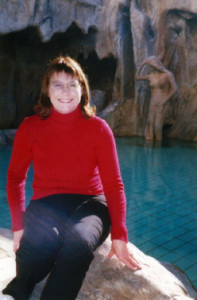
Elaine sitting by the hotel pool
One book for her, a second one for Genevieve. The restaurant was offering a turkey dinner for Christmas night so we signed up for that and drove back to the hotel.
Christmas Day. We wanted to take the coast road that runs parallel to the motorway, but much closer to the sea, all the way from Coral Bay to Agia Napa, if we could, but the one thing we had to do was to see Aphrodite’s rock. We had travelled several kilometres past Paphos when the first brown sign on the way told us to stop at Paphos Castle.
The big brown road signs indicate sites of interest to the visitor. The site wasn’t open because it was Christmas Day, but a small sign next to the ice-cream vendor-cum-ticket booth said entry to the site was free, the visitor only paid to enter the museum. It turns out that Palaia Paphos was the original location of Paphos and the new town was built in its present location, as a port, when this castle was taken by the Persians in – listen carefully – 500BC.
The town was already 1200 years old … A temple to Aphrodite had been built there in 1000 BC. Some of the original neolithic stones are still in place in parts of the foundations and the lower walls. The neolithic stones are the largest building blocks on the site. There are parts of the castle that are Persian, Byzantine and Roman. My guide book said there was a mosaic floor featuring the story of Leda and the swan in a Roman villa 200m from the castle itself.
This particular mosaic is depicted on many of the postcards of Cyprus and, apart from the statue of Aphrodite herself, is the most memorable and charming Cypriot image. We spent more than half an hour looking and eventually, having climbed through a hole in the fence to a little outbuilding that was mostly a roof, we were able to look at this most beautiful mosaic. Leda is in an argument with a swan and she is about to sweep away in a huff, swinging a corner of her diaphanous dress in a dramatic gesture. The angry swan is a metamorphosed Zeus, but I’m not familiar with the story.
The picture, though, is a wonderfully crafted piece all the more remarkable because the colours are not painted on the tiny mosaic tiles; the colours used are those of the stones themselves. . It wasn’t very big – I doubt that the whole mosaic was a metre square, decorated border included – but the movement, the humour and the passion were so lovingly and colourfully depicted that we could see immediately why Leda’s mosaic was so well known across the whole island. We felt privileged; we had finally seen Leda and the swan.
Opposite the castle was a small 12th century Byzantine church. It too, was closed, but we did wonder why there was a wrapping of string all the way around the building, about 8ft off the ground. The church in Polis was similarly wrapped, too.
We headed for Aphrodite’s Rock and we had a magnificent view from the road above of three rocks in a deep blue sea. When we drove up to the beach, we found that the largest rock was called Petro tou Romiou (The Rock of Romius) and that Aphrodite was born out of the foam of the waves around the rock. That’s how she was named – afros, the sea foam. We had a cup of coffee in a kiosk nearby and looked out over the stunning blue Mediterranean Sea on a beautiful Christmas morning while we watched the waves splash and crash and foam around the rocks and onto the beach and listened to them telling us one of the great stories of ancient civilisation.
We followed the sign to the Sanctury of Apollo Hylates. It, too, was closed on Christmas Day but some people who were leaving showed us where the hole in the fence was. On this site was the best preserved and most complete set of Roman buildings we have seen so far – anywhere – but even so, most of what was there were foundations. It seems that almost everything on the island was flattened by several earthquakes in the 4th century.
There were four main buildings: a barracks that held troops to guard the temple, with an ablutions block and toilets – you could even see the Roman tile pipes, and the much smaller lead pipes, that were part of the plumbing. There was a gallery, which was a narrow building at least 50m long, where the Governor hung pictures and other objects of art for visitors to admire. There was a Roman bath-house with the most complete hypocaust we have seen. The column of tiles holding up the floor would have been a metre high, and the hole where the copper boiler once sat would have held a boiler of about 1.5m in diameter and about 3m high.
The fourth building was the most spectacular because it was the original temple to Apollo, partially restored. My guide book says it was so small, the Romans must have held the ceremonies outdoors. There were several new columns modelled on the very old one that was still standing when the restoration was attempted and part of the back wall was full height. It would have been majestic in its day and it had a panoramic view over the valley and off to the hills in the background.
About 1/2km down the road, unheralded, was a Roman games venue with a sign that said The Stadium. We just sort of drove into it and it was quite a sight in the deeply gathering gloom. The walls were big blocks of sandstone arranged in terraces to about 3m high on both sides of a dead flat floor at least 120m long but only about 50m wide. I have no idea what they did in there, but it was a very good venue for it. We were forced to go back to town because it was so dark, and we hadn’t even got as far as Lemisol. There are lots of other places we should go to if we ever go back, but our adventures were intensely satisfying and we both felt that we had seen and done as much as was possible on a quiet, relaxing holiday to Cyprus.
We arrived, washed, changed and in our Sunday best, exactly on time for our appointment with Christmas dinner at the Greek restaurant in the Coral Bay village centre. The chef made the most tender and succulent turkey I have ever tasted, with a sumptuous stuffing of ground chestnuts, honey, cinnamon and prunes along with all the usual trimmings of veges and baked potatoes. Then he put out the Christmas puds, individually cooked as dumpling-sized cakes in pottery bowls with brandy sauce and a crepe suzette. There were Christmas candles all around us and hanging webs of sparkling glow-worm lights on a background of Greek fishing vessels, a small Christmas tree and heavy wooden furniture. We had a truly magical night.
On Boxing Day morning we packed up and left Cyprus, arriving in England after dark to a cold, wet, wintry welcome at Luton.



